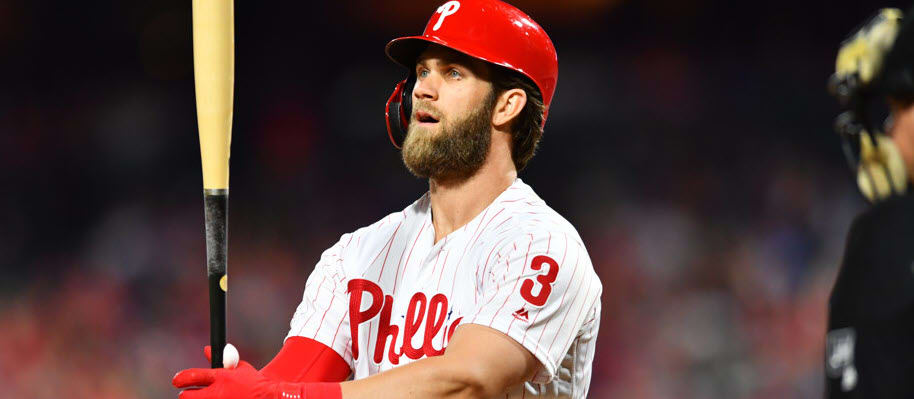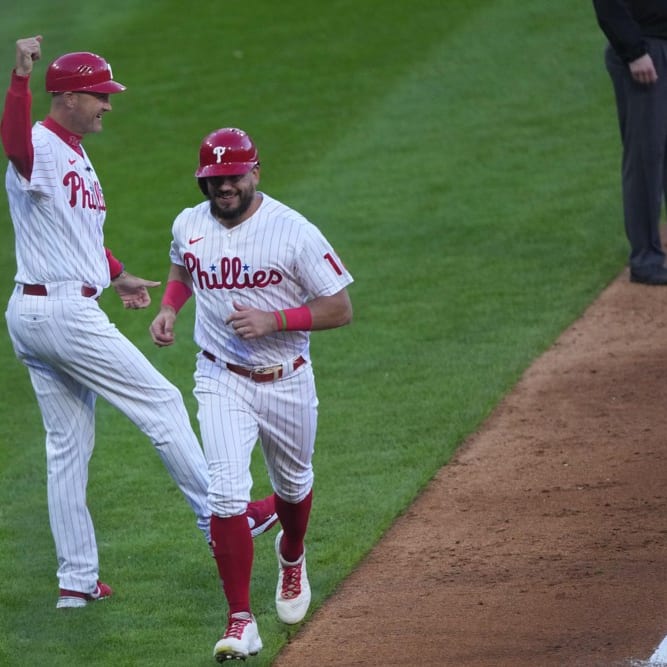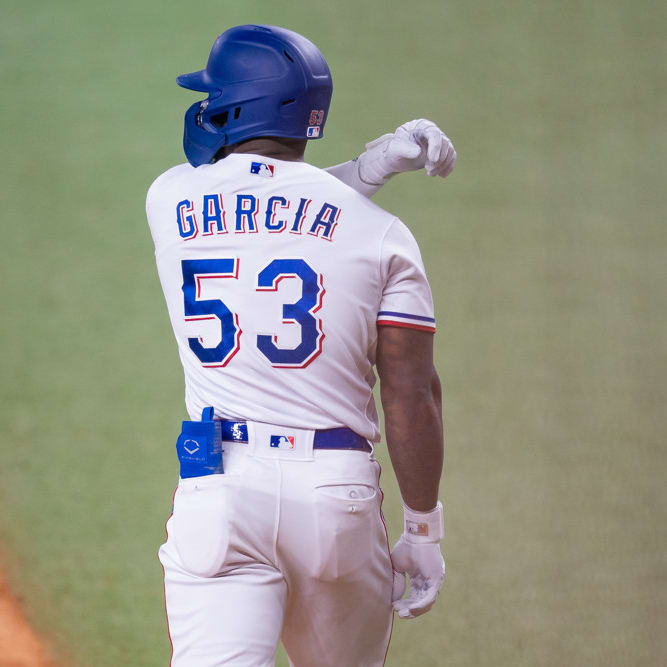This article is part of our MLB Barometer series.
We're more than a full week into August and are fully immersed in the dog days of summer. While the non-competitive teams in your leagues may get even worse the rest of the way as the fantasy community begins shifting its focus to football, there's plenty of edge still to be had in the baseball world for those still paying attention.
Perhaps the most important thing that's happened over the past week or so is that we've had the chance to see how team's trade-deadline acquisitions are affecting their roster, as well as who's had the chance to step up for teams that have traded players. Smart fantasy players are rightly wary of overreacting to small samples, but that applies to statistical anomalies, not player usage.
It doesn't take more than a few games for it to become apparent that Adam Frazier will remain a near-everyday player following his move to San Diego and that he'll hit in one of the first two spots in the order, or that Brad Hand doesn't seem to be walking into a closing role in Toronto. There was plenty of profit to be made in predicting how those moves would change players' values prior to their trades, but there's still some to be made in being quick to accurately assess how lineups and roles will shake out going forward.
While we've now hit the two-thirds mark of the season, there's still plenty of time to improve your place in the standings. If you're sitting
We're more than a full week into August and are fully immersed in the dog days of summer. While the non-competitive teams in your leagues may get even worse the rest of the way as the fantasy community begins shifting its focus to football, there's plenty of edge still to be had in the baseball world for those still paying attention.
Perhaps the most important thing that's happened over the past week or so is that we've had the chance to see how team's trade-deadline acquisitions are affecting their roster, as well as who's had the chance to step up for teams that have traded players. Smart fantasy players are rightly wary of overreacting to small samples, but that applies to statistical anomalies, not player usage.
It doesn't take more than a few games for it to become apparent that Adam Frazier will remain a near-everyday player following his move to San Diego and that he'll hit in one of the first two spots in the order, or that Brad Hand doesn't seem to be walking into a closing role in Toronto. There was plenty of profit to be made in predicting how those moves would change players' values prior to their trades, but there's still some to be made in being quick to accurately assess how lineups and roles will shake out going forward.
While we've now hit the two-thirds mark of the season, there's still plenty of time to improve your place in the standings. If you're sitting on the fringes of competitiveness and feeling down about your spot, look to the Phillies for inspiration. Their playoff odds (per FanGraphs) sat at just 18.2 percent on the final day of August, but they now have a 56.8 percent chance of making the postseason after ripping off an eight-game winning streak, a run that looks all the more impressive considering that the closer they acquired on deadline day (Ian Kennedy) has allowed five runs in 4.1 innings thus far for his new team. More on Kennedy later as part of a look at the players who have most impressed or disappointed thus far in the second half.
RISERS
 Bryce Harper, OF, Phillies: Harper has occupied a strange space in baseball culture ever since he burst onto the scene as a 16-year-old amateur. That kind of hype raised expectations to impossible levels, as did his incredible age-22 season back in 2015, in which he finished with a 197 wRC+ and 9.3 fWAR. That season was nestled between a pair of seasons in which he produced a wRC+ no better than 115, but while he's never come close to his 2015 form, it would be tremendously unfair to call him a disappointment over his last few years. He produced some of his best work in last year's shortened season, with his 151 wRC+ ranking as his third-best finish despite the fact that he underperformed his xSLG by 116 points. He was banged up throughout the first half and looked to be trending toward one of his strong but not dominant seasons, carrying a .282/.378/.520 line into the All-Star break. Since then, however, he's been on an absolute tear, hitting .370/.516/.740 through the first 23 games of the second half. His 21:14 BB:K over that stretch demonstrates how locked in he's been at the plate, and considering that he also walked more than he struck out last season, it wouldn't be unheard of for him to keep that impressive mark going.
Bryce Harper, OF, Phillies: Harper has occupied a strange space in baseball culture ever since he burst onto the scene as a 16-year-old amateur. That kind of hype raised expectations to impossible levels, as did his incredible age-22 season back in 2015, in which he finished with a 197 wRC+ and 9.3 fWAR. That season was nestled between a pair of seasons in which he produced a wRC+ no better than 115, but while he's never come close to his 2015 form, it would be tremendously unfair to call him a disappointment over his last few years. He produced some of his best work in last year's shortened season, with his 151 wRC+ ranking as his third-best finish despite the fact that he underperformed his xSLG by 116 points. He was banged up throughout the first half and looked to be trending toward one of his strong but not dominant seasons, carrying a .282/.378/.520 line into the All-Star break. Since then, however, he's been on an absolute tear, hitting .370/.516/.740 through the first 23 games of the second half. His 21:14 BB:K over that stretch demonstrates how locked in he's been at the plate, and considering that he also walked more than he struck out last season, it wouldn't be unheard of for him to keep that impressive mark going.
 Joey Votto, 1B, Reds: It's tough to find a hitter hotter than Votto is right now. For much of the early part of the season, he appeared to be heading toward his last days as an everyday player (hardly a shame for a 37-year-old), as he hit just .237/.321/.414 in his first 47 games. He's been something else entirely over his last 35 contests, however, slashing .320/.418/.742 while homering 15 times, the highest total among all hitters since that run began. He's homered 11 times in his last 14 games, including nine in a seven-game stretch in late July. That's a particularly remarkable feat given that a lack of elite power has been the primary knock on Votto's otherwise outstanding career; he's managed 30 homers in just two of his 15 major-league seasons despite playing a bat-first position in a homer-friendly park. There's reason to believe that Votto's power baseline truly has changed this season, however. He's sacrificed some contact to get there, as his 23.0 percent strikeout rate is nearly three points worse than his previous career high, but his 15.9 percent barrel rate dwarfs his previous Statcast-era best of 9.5 percent.
Joey Votto, 1B, Reds: It's tough to find a hitter hotter than Votto is right now. For much of the early part of the season, he appeared to be heading toward his last days as an everyday player (hardly a shame for a 37-year-old), as he hit just .237/.321/.414 in his first 47 games. He's been something else entirely over his last 35 contests, however, slashing .320/.418/.742 while homering 15 times, the highest total among all hitters since that run began. He's homered 11 times in his last 14 games, including nine in a seven-game stretch in late July. That's a particularly remarkable feat given that a lack of elite power has been the primary knock on Votto's otherwise outstanding career; he's managed 30 homers in just two of his 15 major-league seasons despite playing a bat-first position in a homer-friendly park. There's reason to believe that Votto's power baseline truly has changed this season, however. He's sacrificed some contact to get there, as his 23.0 percent strikeout rate is nearly three points worse than his previous career high, but his 15.9 percent barrel rate dwarfs his previous Statcast-era best of 9.5 percent.
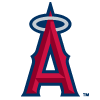 Patrick Sandoval, SP, Angels: Few pitchers have impressed me more than Sandoval this season. He was on my radar heading into the year as a late-round flyer, as his 5.33 ERA in 76 innings over the last two years came with a far better 4.01 xFIP, but my expectations were modest at best, as that's hardly an elite number and he wasn't considered more than a back-end starter prospect. He didn't make his season debut until May and finished that month with a mediocre set of peripherals as a swingman, but what he's accomplished in 10 starts since the beginning of June is hard to ignore. He's recorded a well-deserved 3.25 ERA over that stretch, combining a 29.7 percent strikeout rate with a 51.0 percent groundball rate. Pitchers who get so many whiffs while keeping what contact they do allow on the ground are incredibly rare. Since 2002, the first year for which we have groundball rates available, the only qualified starters to meet both marks over a full season were Clayton Kershaw in 2014, Stephen Strasburg in 2019 and Luis Castillo in last year's shortened season. Sandoval will have to keep up this kind of form for quite some time before he truly belongs in that sort of company, but there's a lot to get excited about here, especially for a lefty who's still just 24 years old.
Patrick Sandoval, SP, Angels: Few pitchers have impressed me more than Sandoval this season. He was on my radar heading into the year as a late-round flyer, as his 5.33 ERA in 76 innings over the last two years came with a far better 4.01 xFIP, but my expectations were modest at best, as that's hardly an elite number and he wasn't considered more than a back-end starter prospect. He didn't make his season debut until May and finished that month with a mediocre set of peripherals as a swingman, but what he's accomplished in 10 starts since the beginning of June is hard to ignore. He's recorded a well-deserved 3.25 ERA over that stretch, combining a 29.7 percent strikeout rate with a 51.0 percent groundball rate. Pitchers who get so many whiffs while keeping what contact they do allow on the ground are incredibly rare. Since 2002, the first year for which we have groundball rates available, the only qualified starters to meet both marks over a full season were Clayton Kershaw in 2014, Stephen Strasburg in 2019 and Luis Castillo in last year's shortened season. Sandoval will have to keep up this kind of form for quite some time before he truly belongs in that sort of company, but there's a lot to get excited about here, especially for a lefty who's still just 24 years old.
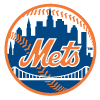 Luis Castillo, SP, Reds: Speaking of Castillo, it looks like he's fully back to his old self. He's traditionally been a slow starter, posting a career 4.78 ERA through the end of May, but his start this year was far worse than normal. Through the first two months of this season, he owned an awful 7.22 ERA, with his strikeout rate plummeting from a career-best 30.5 percent last season to just 19.3 percent. A switch flipped once the calendar hit June, however, and he's since gone on to cruise to a 1.91 ERA over his last 12 starts. He's been remarkably steady, allowing no more than three runs in any of those outings. The strikeouts haven't fully returned, as he owns merely an above-average 26.5 percent strikeout rate over that full stretch, though that's changed over his last four starts, a run in which he's struck out an average of eight batters per outing. He's also recorded an excellent 60.0 percent groundball rate over those four starts, a sign that he's truly returned to peak form and should pitch like the ace he was drafted to be for the rest of the year.
Luis Castillo, SP, Reds: Speaking of Castillo, it looks like he's fully back to his old self. He's traditionally been a slow starter, posting a career 4.78 ERA through the end of May, but his start this year was far worse than normal. Through the first two months of this season, he owned an awful 7.22 ERA, with his strikeout rate plummeting from a career-best 30.5 percent last season to just 19.3 percent. A switch flipped once the calendar hit June, however, and he's since gone on to cruise to a 1.91 ERA over his last 12 starts. He's been remarkably steady, allowing no more than three runs in any of those outings. The strikeouts haven't fully returned, as he owns merely an above-average 26.5 percent strikeout rate over that full stretch, though that's changed over his last four starts, a run in which he's struck out an average of eight batters per outing. He's also recorded an excellent 60.0 percent groundball rate over those four starts, a sign that he's truly returned to peak form and should pitch like the ace he was drafted to be for the rest of the year.
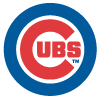 Rafael Ortega, OF, Cubs: A teardown like the one the Cubs executed at the deadline is theoretically designed to give opportunities to younger players. Instead, it's been the 30-year-old Ortega, who's already playing for his fifth team, who's been the primary player to take advantage of a regular role. He came into the year hitting just .229/.287/.290 in 447 plate appearances split across an eight-year span, but he's emerged to hit .319/.374/.519 in 148 trips to the plate this season while adding six steals. The majority of his damage has come in the second half, in which he's hit .394/.449/.662, and he's been even better in the tiny sample since the deadline, hitting .423 with three homers in seven games. As you might expect for a sample this small from a player this unheralded, there's been a lot of good fortune here, but you shouldn't just look at his .402 BABIP and write him off completely. His .296 xBA and .448 xSLG are both strong. Toss in the fact that he's been locked into the leadoff role (a spot that has value even in lineups as weak as this post-teardown Cubs unit) and he looks like a player worth taking a flyer on in most formats.
Rafael Ortega, OF, Cubs: A teardown like the one the Cubs executed at the deadline is theoretically designed to give opportunities to younger players. Instead, it's been the 30-year-old Ortega, who's already playing for his fifth team, who's been the primary player to take advantage of a regular role. He came into the year hitting just .229/.287/.290 in 447 plate appearances split across an eight-year span, but he's emerged to hit .319/.374/.519 in 148 trips to the plate this season while adding six steals. The majority of his damage has come in the second half, in which he's hit .394/.449/.662, and he's been even better in the tiny sample since the deadline, hitting .423 with three homers in seven games. As you might expect for a sample this small from a player this unheralded, there's been a lot of good fortune here, but you shouldn't just look at his .402 BABIP and write him off completely. His .296 xBA and .448 xSLG are both strong. Toss in the fact that he's been locked into the leadoff role (a spot that has value even in lineups as weak as this post-teardown Cubs unit) and he looks like a player worth taking a flyer on in most formats.
 Sam Hilliard, OF, Rockies: Getting excited about a small sample from an unremarkable Rockies hitter is a time-honored tradition in the fantasy baseball world. Hilliard himself generated that excitement just two years ago by homering seven times and slashing .273/.356/.649 in 27 games. He followed that up by hitting just .210/.272/.438 in 36 games last year and continued to disappoint early this season, slashing .108/.154/.324 while striking out in 19 of his 39 plate appearances before being demoted in early May. The 27-year-old was recalled to start the second half, however, and he's again looking like a very exciting option, hitting .304/.381/.696 with six homers in 63 trips to the plate. Four of those homers have come in his last six games. It's admittedly not a large sample and we've been burned by Hilliard before, but he's at least cut his strikeout rate to a palatable 27.0 percent since his call-up, and it doesn't take much for a hitter with a regular role at Coors Field to be worth a look.
Sam Hilliard, OF, Rockies: Getting excited about a small sample from an unremarkable Rockies hitter is a time-honored tradition in the fantasy baseball world. Hilliard himself generated that excitement just two years ago by homering seven times and slashing .273/.356/.649 in 27 games. He followed that up by hitting just .210/.272/.438 in 36 games last year and continued to disappoint early this season, slashing .108/.154/.324 while striking out in 19 of his 39 plate appearances before being demoted in early May. The 27-year-old was recalled to start the second half, however, and he's again looking like a very exciting option, hitting .304/.381/.696 with six homers in 63 trips to the plate. Four of those homers have come in his last six games. It's admittedly not a large sample and we've been burned by Hilliard before, but he's at least cut his strikeout rate to a palatable 27.0 percent since his call-up, and it doesn't take much for a hitter with a regular role at Coors Field to be worth a look.
FALLERS
 Jarren Duran, OF, Red Sox: There were plenty of reasons to get excited about Duran when he debuted at the start of the second half. After building a reputation in the minors as a speedy, contact-oriented player, he changed up his swing to add more power, and the change appeared to be working. He homered 15 times in 46 games for Triple-A Worcester to open the year while striking out a completely acceptable 23.7 percent of the time. Unfortunately, he's become the latest in a long line of players to struggle significantly in their first taste of the big leagues this season. Nothing in his .196/.220/.357 slash line through his first 18 games is anything close to good, and his 39.0 percent strikeout rate indicates those numbers are well-deserved. He hasn't gotten on base nearly often enough to show off his wheels, stealing just a single base. His 5.9 percent barrel rate would tie him for 111th out of 135 qualified hitters, so his contact has been weak as well as infrequent. The Red Sox remain locked into a very tight playoff race, so they might not be able to give him enough at-bats to work his way through his struggles if he doesn't turn things around soon.
Jarren Duran, OF, Red Sox: There were plenty of reasons to get excited about Duran when he debuted at the start of the second half. After building a reputation in the minors as a speedy, contact-oriented player, he changed up his swing to add more power, and the change appeared to be working. He homered 15 times in 46 games for Triple-A Worcester to open the year while striking out a completely acceptable 23.7 percent of the time. Unfortunately, he's become the latest in a long line of players to struggle significantly in their first taste of the big leagues this season. Nothing in his .196/.220/.357 slash line through his first 18 games is anything close to good, and his 39.0 percent strikeout rate indicates those numbers are well-deserved. He hasn't gotten on base nearly often enough to show off his wheels, stealing just a single base. His 5.9 percent barrel rate would tie him for 111th out of 135 qualified hitters, so his contact has been weak as well as infrequent. The Red Sox remain locked into a very tight playoff race, so they might not be able to give him enough at-bats to work his way through his struggles if he doesn't turn things around soon.
 Adolis Garcia, OF, Rangers: Garcia was bound to fall back to earth at some point. Twenty-eight-year-olds with a grand total of 24 major-league plate appearances generally don't hit .270/.312/.527, as Garcia did in the first half. Similarly, players who combine a 4.8 percent walk rate with a 30.6 percent strikeout rate generally can't sustain a 127 wRC+. That strong first half certainly wasn't entirely a fluke, as Garcia did hit the ball hard enough to cover his plate-discipline flaws, producing a 15.6 percent barrel rate, the 13th-best mark among qualified hitters. That barrel rate has collapsed to just 5.8 percent thus far in the second half, and he's striking out at a barely better 29.3 percent clip, so it's no surprise to see him hit a miserable .171/.232/.316 since the break. Garcia's excellent early performance shouldn't be forgotten and should still factor into our evaluations of him, but it still represents a relatively small blip in an otherwise ordinary career. There's little doubt he's a legitimate big-league hitter, something which wasn't apparent prior to this year, but he may ultimately not be much more than a mediocre one.
Adolis Garcia, OF, Rangers: Garcia was bound to fall back to earth at some point. Twenty-eight-year-olds with a grand total of 24 major-league plate appearances generally don't hit .270/.312/.527, as Garcia did in the first half. Similarly, players who combine a 4.8 percent walk rate with a 30.6 percent strikeout rate generally can't sustain a 127 wRC+. That strong first half certainly wasn't entirely a fluke, as Garcia did hit the ball hard enough to cover his plate-discipline flaws, producing a 15.6 percent barrel rate, the 13th-best mark among qualified hitters. That barrel rate has collapsed to just 5.8 percent thus far in the second half, and he's striking out at a barely better 29.3 percent clip, so it's no surprise to see him hit a miserable .171/.232/.316 since the break. Garcia's excellent early performance shouldn't be forgotten and should still factor into our evaluations of him, but it still represents a relatively small blip in an otherwise ordinary career. There's little doubt he's a legitimate big-league hitter, something which wasn't apparent prior to this year, but he may ultimately not be much more than a mediocre one.
 Rich Hill, SP, Mets: To be fair to Hill, it's remarkable that he's still in the league at all, given that he's now 41 years old. This may be the end of the line for the lefty, however, who's shown his age more than ever over his last several starts. After cruising to a 3.05 ERA in his first 12 starts, he's struggled to a 5.03 ERA in his last 10, a run that includes his last seven as a Ray and his first three as a Met. The Rays have a well-earned reputation for being smart with their transactions, and it's not hard to decipher what they saw that made them want to move on. The spin rate on his excellent curveball dropped from 2,800 rpm in May to 2,586 rpm in June, which almost exactly lines up with the MLB's crackdown on foreign substances. That's corresponded with a big drop in his strikeout rate, which came in at 26.4 percent through the end of May but has fallen to just 17.4 percent since the start of June. At his age, and with a very clear explanation for the decline in whiffs, it's hard to imagine him bouncing back down the stretch.
Rich Hill, SP, Mets: To be fair to Hill, it's remarkable that he's still in the league at all, given that he's now 41 years old. This may be the end of the line for the lefty, however, who's shown his age more than ever over his last several starts. After cruising to a 3.05 ERA in his first 12 starts, he's struggled to a 5.03 ERA in his last 10, a run that includes his last seven as a Ray and his first three as a Met. The Rays have a well-earned reputation for being smart with their transactions, and it's not hard to decipher what they saw that made them want to move on. The spin rate on his excellent curveball dropped from 2,800 rpm in May to 2,586 rpm in June, which almost exactly lines up with the MLB's crackdown on foreign substances. That's corresponded with a big drop in his strikeout rate, which came in at 26.4 percent through the end of May but has fallen to just 17.4 percent since the start of June. At his age, and with a very clear explanation for the decline in whiffs, it's hard to imagine him bouncing back down the stretch.
 Ian Kennedy, RP, Phillies: Kennedy began the season with a team that has won 34.8 percent of its games and now plays for a team that has won at a 52.7 percent clip, so a simplistic analysis would make the case that the deadline was a clear positive for his value. The majority of a closer's value comes from saves, after all, and it's easier to get saves on a team that wins games. It's worth wondering whether Kennedy's specific skillset makes him a closer-level pitcher in Philadelphia, however. His 28.1 percent strikeout rate and 6.2 percent walk rate and the season are both strong numbers (albeit not necessarily good enough to close for most teams), but his 28.1 percent groundball rate is worryingly low. That might work in Texas, where Globe Life Field has been suppressing homers in the first two years of its existence, but it could cause issues in the cozy confines of Citizens Bank Park. Kennedy has already allowed a homer in three of his first five outings for his new team, though his struggles extend back further than that. In his last 17 appearances, he's struggled to a 5.51 ERA. His grip on the closer role may not be particularly firm even given the uninspiring alternatives in the Phillies' bullpen.
Ian Kennedy, RP, Phillies: Kennedy began the season with a team that has won 34.8 percent of its games and now plays for a team that has won at a 52.7 percent clip, so a simplistic analysis would make the case that the deadline was a clear positive for his value. The majority of a closer's value comes from saves, after all, and it's easier to get saves on a team that wins games. It's worth wondering whether Kennedy's specific skillset makes him a closer-level pitcher in Philadelphia, however. His 28.1 percent strikeout rate and 6.2 percent walk rate and the season are both strong numbers (albeit not necessarily good enough to close for most teams), but his 28.1 percent groundball rate is worryingly low. That might work in Texas, where Globe Life Field has been suppressing homers in the first two years of its existence, but it could cause issues in the cozy confines of Citizens Bank Park. Kennedy has already allowed a homer in three of his first five outings for his new team, though his struggles extend back further than that. In his last 17 appearances, he's struggled to a 5.51 ERA. His grip on the closer role may not be particularly firm even given the uninspiring alternatives in the Phillies' bullpen.

